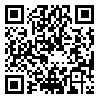شمارۀ جدید فصلنامه (پاییز1404) منتشر شد
دوره 11، شماره 2 - ( 8-1399 )
جلد 11 شماره 2 صفحات 265-237 |
برگشت به فهرست نسخه ها
Download citation:
BibTeX | RIS | EndNote | Medlars | ProCite | Reference Manager | RefWorks
Send citation to:



BibTeX | RIS | EndNote | Medlars | ProCite | Reference Manager | RefWorks
Send citation to:
Ghanimati H, mansouri F, dadandish P. (2020). Social integration and the relationship of normative plurality with it. Social Problems of Iran. 11(2), 237-265.
URL: http://jspi.khu.ac.ir/article-1-3232-fa.html
URL: http://jspi.khu.ac.ir/article-1-3232-fa.html
غنیمتی حسن، منصوری فردین، داداندیش پروین.(1399). انسجام اجتماعی و رابطه تشتت هنجاری با آن مسائل اجتماعی ایران 11 (2) :265-237
حسن غنیمتی*1 

 ، فردین منصوری2
، فردین منصوری2 

 ، پروین داداندیش3
، پروین داداندیش3 




 ، فردین منصوری2
، فردین منصوری2 

 ، پروین داداندیش3
، پروین داداندیش3 


1- دانشگاه آزاد اسلامی، واحد قزوین، ایران. ، h-ghanimati@sbu.ac.ir
2- دانشجوی دکتری سیاستگذاری فرهنگی، گروه جامعه شناسی، دانشگاه خوارزمی، تهران، ایران.
3- استادیار گروه علوم سیاسی، دانشکده علوم انسانی، واحد تهران غرب، دانشگاه آزاد اسلامی، تهران، ایران.
2- دانشجوی دکتری سیاستگذاری فرهنگی، گروه جامعه شناسی، دانشگاه خوارزمی، تهران، ایران.
3- استادیار گروه علوم سیاسی، دانشکده علوم انسانی، واحد تهران غرب، دانشگاه آزاد اسلامی، تهران، ایران.
چکیده: (2840 مشاهده)
یکی از عوامل مهم تأثیرگذار بر روی توسعۀ اجتماعی، وضعیت انسجام اجتماعی جوامع میباشد. جامعهشناسان، عوامل متعددی را به عنوان عوامل تأثیرگذار بر انسجام دخیل میدانند. یکی از مهمترین این عوامل، ویژگیهای فرهنگی جوامع، وضعیت تشتت و چندگانگی هنجاری و نحوه مواجه با این وضعیت در جوامع است. مدل هرای مختلفی از تأثیرگذاری کامل تا عدم تأثیرگذاری ویژگیهای فرهنگی بر روی انسجام اجتماعی در ادبیات نظری مطرح شده است. بر اساس هدف مقاله، به نظر میرسد، جوامعی که با میزان بیشتری از تشتت هنجاری مواجه هستند، سطح انسجام پایینتری دارند. به منظور آزمون این مدعا یک مطالعۀ تطبیقی با استفاده از دادههای ثانویه پیمایش ارزشهای جهانی (2015- 1995)، اقلیتهای در معرض خطر، بانک جهانی، آزادیهای مذهبی و مطالعات اجتماعی انجام شده است. دورۀ زمانی دادههای این مطالعه از 1995 تا 2015 و شامل 109 کشور میشود. نتایج نشان داد؛ جوامعی با میزان بالایی از چندگانگی و تشتت هنجاری، میزان پایینی از انسجام اجتماعی را دارا میباشند. شکل رابطه بین این دو متغیر هم برای تشتت هنجاری کل و هم برای اجزای سازندۀ آن تقریباً به صورت خطی بوده است. کشورهای آمریکای شمالی کمترین میزان تشتت هنجاری و بیشترین میزان انسجام را دارا بودهاند و کشورهای آفریقایی بالعکس از میزان بیشتری از تشتت هنجاری و میزان پایینی از انسجام برخوردارند. ایران از حیث انسجام اجتماعی در میان 109 کشور جهان رتبه 87 و از حیث تشتت و چندگانگی هنجاری رتبه 31 در میان 61 کشور را دارد.
نوع مقاله: پژوهشی اصیل |
دریافت: 1399/5/4 | پذیرش: 1399/10/30 | انتشار: 1399/12/24
دریافت: 1399/5/4 | پذیرش: 1399/10/30 | انتشار: 1399/12/24
فهرست منابع
1. چلبي، مسعود ( 1382). جامعه شناسي نظم، تهران: نشر نی.
2. غنیمتی، حسن (1396). بررسی انسجام اجتماعی با تاکید بر ایران (مورد پژوهی چندگانه تاریخی)، رساله دکتری، گروه جامعه-شناسی، دانشگاه شهید بهشتی.
3. محسني، منوچهر. (1379). بررسي آگاهيها، نگرشها و رفتارهاي اجتماعي - فرهنگي در ايران، تهران: نشر دبیرخانه شورای فرهنگ عمومی.
4. Blattman,C & Miguel,E.(2010) "Civil War." Journal of Economic Literature, 48(1):3-57. [DOI:10.1257/jel.48.1.3]
5. Breidahl, K., Holtug, N., & Kongshøj, K. (2018). Do Shared Values Promote Social Cohesion? If So, Which? Evidence from Denmark. European Political Science Review, 10(1): 97-118. [DOI:10.1017/S1755773916000266]
6. Camilla Pagani (2014) Diversity and Social Cohesion, Intercultural Education, 25(4): 300-311, [DOI:10.1080/14675986.2014.926158]
7. Chai, S.K & Hechter, M.(1998) "A Theory of the State and of Social order": Chapter 2 in Dreian, P & Fararo, T. J (eds) The Problem of Solidarity: Theories and Models. New York: Gordon and Breach Publisher.
8. Collins, R. (2003) "Emotional Energy and the Transient Emotions", Chapter 3 in Interaction Ritual Chains. Princeton: Princeton University Press.
9. Collins, R.(1995) "Prediction in Macrosociology: The Case of the Soviet Collapse." American Journal of Sociology, 100(6): 1552-1593 [DOI:10.1086/230672]
10. Collins, R. Hanneman, R.(1998) "Modeling The Interaction Ritual Theory Of Solidarity." In Dreian, P & Fararo, T.(eds) The Problem of Solidarity: Theories and Models." New York: Gordon and Breach.
11. Dragolov G., Ignácz Z.S., Lorenz J., Delhey J., Boehnke K., Unzicker K. (2016) Theoretical Framework of the Social Cohesion Radar. in: Social Cohesion in the Western World. Springer Briefs in Well-Being and Quality of Life Research. Springer, Cham. [DOI:10.1007/978-3-319-32464-7]
12. Ellis, D. (1971) "The Hobbesian Problem of Order: A Critical Appraisal of the Normative Solution." American Sociological Review, 36: 692-703. [DOI:10.2307/2093599]
13. Elster, J. (1989). The Cement of Society: A Survey of Social Order (Studies in Rationality and Social Change). Cambridge: Cambridge University Press. [DOI:10.1017/CBO9780511624995]
14. Fararo, T.J & Dreian, P.(1998) "The Theory of Solidarity: An Genda of problems": Chapter 1 in Dreian, P & Fararo, T. J (eds) The Problem of Solidarity: Theories and Models. New York: Gordon and Breach Publisher.
15. Fonseca, X. Lukosch, S. , Brazier,F,. (2019) Social Cohesion Revisited: A new definition and how to characterize it, Innovation: The European Journal of Social Science Research, 32(2): 231-253. [DOI:10.1080/13511610.2018.1497480]
16. Goldstone, J.(1991) "Ideology, Cultural Frameworks, and the Process of Revolution." Theory and Society, 20(4): 405-453. [DOI:10.1007/BF00157321]
17. Heise, D. R.(1998) "Conditions for Empathic Solidarity.", Chapter 3 in Dreian, P & Fararo, T. J (eds) The Problem of Solidarity: Theories and models. New York: Gordon and Breach Publisher.
18. Helly, D., Barsky, R., & Foxen, P. (2003). Social Cohesion and Cultural Plurality. The Canadian Journal of Sociology, 28(1): 19-42. [DOI:10.2307/3341873]
19. Hogg, M. A & Vaughan, M.G.(2002) Social Psychology. London: Prentice Hall Press.
20. Hogg, M. A.(1992) The Social Psychology of Group Cohesiveness: From Attraction to Social Identity. New York: New York University Press.
21. Horowitz, D. L.(1998) Structure and Strategy in Ethnic Conflict. Publisher: World Bank.
22. International Institute of Social Studies (ISS).
23. Jenson, J., (2019) Intersections of Pluralism and Social Cohesion, Global Centre for Pluralism.
24. Jenson, J., (1988). Mapping Social Cohesion: The State of Canadian Research. 1st Ed. Canadian Policy Research Networks, Ottawa.
25. Kaufmann, D. Kraay, A. and Pablo Zoido-Lobaton. (1999). "Governance Matters.", Policy Working Paper 2196, Development Economics Group, World Bank.
26. Kaufmann, D. Kraay, A. and Massimo Maastruzzi. (2006). "Measuring Corruption: Myths and Realities", Development Outreach.
27. Kymlicka W. (1995) Multicultural Citizenship. Oxford: Oxford University Press. [DOI:10.1093/0198290918.001.0001]
28. Kolstø, Pål; Tyldum, Guri, (2006) "Common Values and Social Cohesion in Ethnically Divided Societies" Ethnicity Studies/ Etniskumo Studijos .Issue 1:121-146.
29. Li, R. S. K.(2002) "Alternative Routes to State Breakdown: Toward an Integrated Model of Territorial Disintegration." Sociological Theory, 20:1-23. [DOI:10.1111/1467-9558.00148]
30. Markvosky, B & Lawler, E. J.(1994) "A New Theory of Group Solidarity.", in Markvosky, B & O'Brien, J & Heimer, K (eds.), Advances in Group Processes,11: 113-137.
31. McPherson, M., & Smith-Lovin, L.(2002), "Cohesion and Membership duration: Linking Groups, Relations and Individuals in an Ecology of Affiliation.", in (ed.) Advances in Group Processes, 19: 1- 36 [DOI:10.1016/S0882-6145(02)19002-3]
32. Mekoa, Itumeleng & Busari, Dauda. (2018)."Social Cohesion: Its Meaning and Complexities". Journal of Social Sciences. 14: 107-115 [DOI:10.3844/jssp.2018.107.115]
33. Parton, B. (2011), "Stability for Development, Development for Stability: The Relationship Between Regional Organizations and Social Cohesion Through the Lens of the EU and Mercosur". Peabody Journal of Education, 86(2), 129-143. [DOI:10.1080/0161956X.2011.561175]
34. Portes, A., & Vickstrom, E. (2011). "Diversity, Social Capital, and Cohesion". Annual Review of Sociology, 37, 461-479. [DOI:10.1146/annurev-soc-081309-150022]
35. Scheff, T. J.(1967) "A Theory of Social Coordination Applicable to Mixed-Motive Games. Sociometry, 30(3), 215-234. [DOI:10.2307/2786445]
36. Schiefer, D., Van der Noll, J., (2017). "The Essentials of Social Cohesion: A Literature Review". Soc Indic Res 132: 579-603 [DOI:10.1007/s11205-016-1314-5]
37. Scott, S & Marshall, G.(1998) A Dictionary of Sociology. New York: Oxford University Press.
38. Skocpol, T.(1994) Social Revolutions in the Modern World. Cambridge Studies in Comparative Politics. Cambridge, England: Cambridge University Press.
39. Spicker, P. (2014). Cohesion, Exclusion and Social Quality. The International Journal of Social Quality, 4(1): 95-107. [DOI:10.3167/IJSQ.2014.040107]
40. Stanley, M (2017) "Sociological Perspectives on Social Cohesion as the Principal Requirement for Social Stability", South African Review of Sociology, 48 (3): 84-98. [DOI:10.1080/21528586.2017.1299040]
41. Tajfel, H., & Turner, J.(1979) "An integrative theory of intergroup conflict.", Chapter 3 in Austin, G. W. & Worchel, S. (eds) The Social Psychology of Intergroup Relations, Brooks/Cole Pub.
42. Tajfel, H., & Wilkes, H.(1963) "Classification and Quantitative Judgment." British Journal of Psychology, 54: 101-114. [DOI:10.1111/j.2044-8295.1963.tb00865.x]
43. Turner, H. J.(2006) Handbook of Sociological Theory. New York: Springer.
44. Turner, B. S. & Rojek, C.(2001). Theory, Culture & Society: Society and Culture: Principles of Scarcity and Solidarity London: Sage Publications Ltd.
45. Turner, J. C.(1985) "Social Categorization and the Self-concept: A Social Cognitive Theory of Group behaviour." In E. J. Lawler (Ed.). Advances in Group Processes. 2: 77-122.
46. United Nations.(2005) "The Inequality Predicament." United Nations
47. White, D. R. & Harary, F.(2001) "The Cohesiveness of Blocks in Social Networks: Node Connectivity and Conditional Density." Sociological Methodology, 31: 305-359. [DOI:10.1111/0081-1750.00098]
48. www.World Values Survey(WVS)
49. www.data.worldbank.org/indicator/
50. www.cidcm.umd.edu/mar
ارسال پیام به نویسنده مسئول
| بازنشر اطلاعات | |
 |
این مقاله تحت شرایط Creative Commons Attribution-NonCommercial 4.0 International License قابل بازنشر است. |




